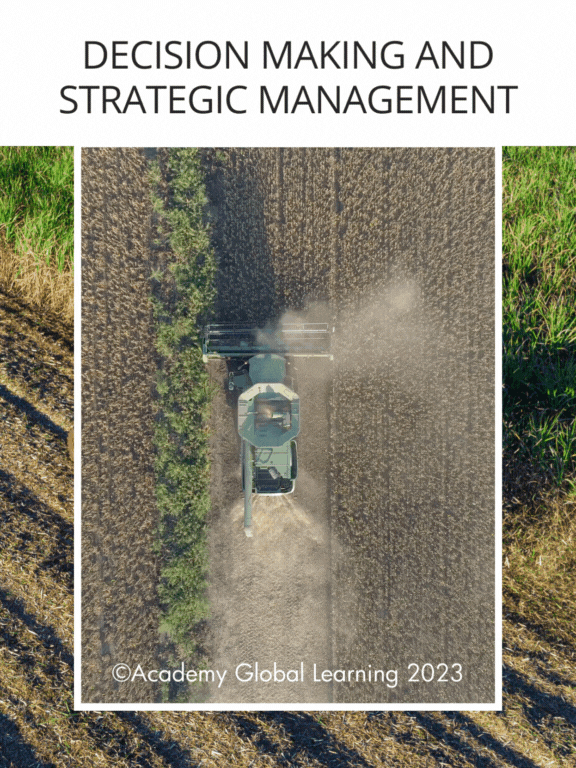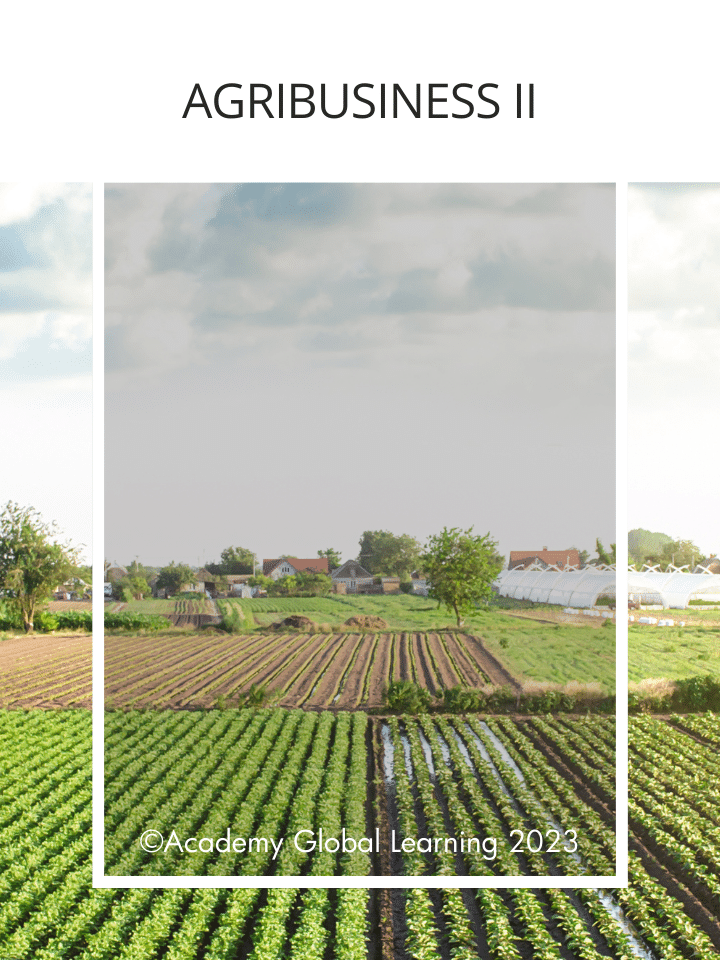

This book developed by ©Academy Global Learning 2020
All rights reserved under ©Academy Global Learning 2020. No part of this publication may be reproduced, stored in a retrieval system, or transmitted in any form or by any means, electronic, mechanical, photocopying, recording, or otherwise, without the prior written permission of the copyright owner.
Designed By:
Christian Alas
Created and illustrated By:
Angelo Romero and Camilo Sanabria

Chapter 2: Decision Making and Strategic Management
Overview: Effective decision-making and strategic management are essential components of successful agribusiness operations. This chapter delves into the principles and tools that help agribusiness managers make informed decisions and develop strategies for growth and sustainability, with a specific focus on the Romanian agricultural context.
Key Concepts in Decision Making and Strategic Management
1. Decision-Making Principles: Decision-making in agribusiness involves selecting the best course of action from various alternatives. It requires careful analysis of data, consideration of risks, and alignment with strategic goals. For Romanian agribusinesses, this means understanding local market conditions, regulatory requirements, and the unique challenges of the Romanian agricultural sector.
Example: A Romanian farmer deciding whether to invest in new irrigation technology must consider the costs, potential yield improvements, water availability, and financial assistance programs offered by the government or EU.
– 2 –
2. Strategic Management Processes: Strategic management involves setting long-term goals and developing plans to achieve them. This process includes assessing internal and external environments, formulating strategies, implementing them, and evaluating their effectiveness. For Romanian agribusinesses, strategic management should align with national agricultural policies and EU regulations.
Example: A cooperative of Romanian vegetable growers developing a strategic plan to expand their market reach by obtaining organic certification and targeting export markets in Western Europe.

– 3 –
3. Tools for Analysis: Several tools can aid in decision-making and strategic management. These include SWOT analysis, budget analysis, and risk assessment. These tools help managers identify strengths, weaknesses, opportunities, and threats, analyze financial performance, and assess potential risks.
Example: Using a SWOT analysis to evaluate the potential of introducing a new crop, such as lavender, in Romania. Strengths might include suitable climate and soil, while threats could be market competition and initial investment costs.
Decision-Making Models and Techniques
1. Cost-Benefit Analysis: Cost-benefit analysis (CBA) is a systematic approach to estimating the strengths and weaknesses of alternatives. It helps determine the best option by comparing the expected costs and benefits.
Example: A Romanian dairy farm considering installing a biogas plant to convert manure into energy. The CBA would include the costs of installation and maintenance against the benefits of reduced energy costs and potential income from selling excess energy.
– 4 –
2. Decision Trees: Decision trees are graphical representations of possible solutions to a decision based on different conditions. They help visualize the consequences of various choices and identify the most beneficial path.
Example: A Romanian agribusiness evaluating whether to diversify into agro-tourism. The decision tree would outline the potential investment costs, expected tourist numbers, and revenue against the risks of low visitor turnout or increased operational costs.
3. Scenario Planning: Scenario planning involves creating detailed and plausible views of different ways the future could unfold. It helps businesses prepare for uncertainties and develop flexible strategies.
Example: Romanian grain producers using scenario planning to anticipate the effects of climate change on crop yields and developing strategies to mitigate risks, such as adopting drought-resistant varieties or diversifying crops.

– 5 –
Challenges and Opportunities in Agribusiness
1. Aligning with National and EU Policies: Romanian agribusinesses must align their strategies with national agricultural policies and EU regulations to access funding, comply with standards, and benefit from trade agreements.
Example: Developing a strategic plan that leverages EU rural development funds to modernize farm equipment and adopt sustainable farming practices.
2. Market Analysis and Competitive Positioning: Understanding the local and international markets is crucial for strategic planning. This involves analyzing market trends, consumer preferences, and competitors’ activities.
Example: Romanian honey producers analyzing demand for organic honey in the EU market and positioning their products as high-quality and sustainably produced to gain a competitive edge.
3. Resource Allocation: Efficient resource allocation ensures that financial, human, and physical resources are used optimally to achieve strategic goals. This involves budgeting, financial planning, and investment decisions.
Example: A Romanian vineyard allocating resources to upgrade its wine production facilities, enhance quality, and market its wines internationally.
– 6 –
Challenges and Opportunities in Romanian Agribusiness
1. Access to Financing: Access to financing is a significant challenge for many Romanian farmers. Developing robust business plans and understanding available financial instruments can help secure necessary funding.
Example: Applying for EU grants and subsidies designed to support rural development and agribusiness modernization.
2. Technological Adoption: Adopting modern agricultural technologies can improve productivity and sustainability. However, the initial investment and lack of technical knowledge can be barriers.
Example: Implementing precision farming techniques, such as GPS-guided machinery and soil sensors, to optimize input use and increase yields.
3. Climate Change Adaptation: Climate change poses risks to Romanian agriculture through increased frequency of extreme weather events and changing growing conditions. Developing strategies to adapt is crucial for long-term sustainability.
Example: Investing in irrigation systems and crop varieties that are more resilient to drought and extreme temperatures.
– 7 –
Case Studies in Decision Making and Strategic Management
1. Case Study: Adopting Organic Farming Practices A Romanian family farm decides to transition to organic farming to meet the growing demand for organic produce in the EU market. The decision-making process involves conducting a SWOT analysis, performing a cost-benefit analysis, and developing a strategic plan to obtain organic certification and market their products effectively.
2. Case Study: Diversifying into Agro-Tourism A Romanian vineyard explores the opportunity to diversify into agro-tourism. The decision involves scenario planning to understand potential visitor numbers, investment requirements, and revenue projections. The strategic plan includes developing tourist facilities, marketing campaigns, and partnerships with local tourism agencies.
3. Case Study: Expanding Export Markets A cooperative of Romanian fruit growers aims to expand their market reach by exporting to Western Europe. The decision-making process includes market analysis to identify target markets, developing a competitive positioning strategy, and securing necessary certifications to meet export standards.
– 8 –
Summary
Effective decision-making and strategic management are vital for the success and sustainability of Romanian agribusinesses. By leveraging tools like SWOT analysis, cost-benefit analysis, and scenario planning, agribusiness managers can make informed decisions that align with national and EU policies, adapt to market trends, and optimize resource use. Understanding and addressing challenges such as access to financing, technological adoption, and climate change adaptation are crucial for capitalizing on opportunities and achieving long-term growth.
– 9 –
Review Questions
1. What are the key principles of decision-making in agribusiness?
2. How can Romanian agribusinesses align their strategies with national and EU policies?
3. Explain the importance of market analysis and competitive positioning in strategic management.
4. Discuss the role of resource allocation in achieving strategic goals.
5. Identify and explain three major challenges faced by Romanian agribusinesses today.
6. How can technology help overcome challenges in Romanian agribusiness?
7. Describe the impact of climate change on Romanian agriculture and potential mitigation strategies.
– 10 –
– 11 –



 Agribusiness Management | Chapter 5: Record Keeping
Agribusiness Management | Chapter 5: Record Keeping  Agribusiness Management | Chapter 3: Farm Supply Management
Agribusiness Management | Chapter 3: Farm Supply Management  Agribusiness Management | Chapter 1: Introduction to Agribusiness
Agribusiness Management | Chapter 1: Introduction to Agribusiness  Agribusiness 2
Agribusiness 2  C11 | Unit 10 | Set 2 | Arts and Culture
C11 | Unit 10 | Set 2 | Arts and Culture  C11 | Unit 10 | Set 1 | Arts and Culture
C11 | Unit 10 | Set 1 | Arts and Culture  C20 | Unit 10 | Set 1 | Future Planning and Goals
C20 | Unit 10 | Set 1 | Future Planning and Goals  C20 | Unit 10 | Set 2 | Future Planning and Goals
C20 | Unit 10 | Set 2 | Future Planning and Goals  C14 | Unit 10 | Set 2 | Global Challenges and Solutions
C14 | Unit 10 | Set 2 | Global Challenges and Solutions  C14 | Unit 10 | Set 1 | Global Challenges and Solutions
C14 | Unit 10 | Set 1 | Global Challenges and Solutions